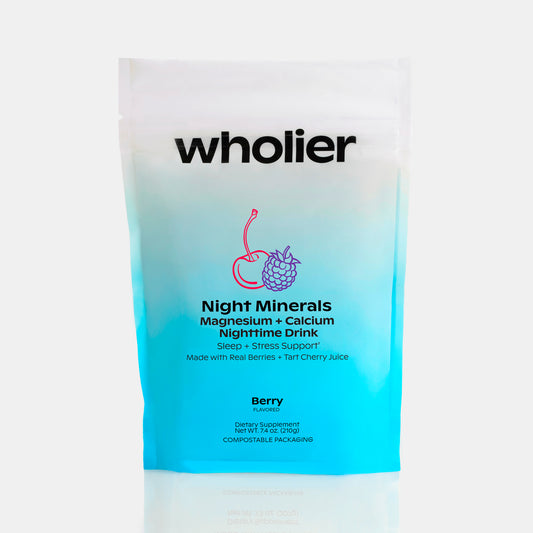
Magnesium Oxide vs. Glycinate: The Truth About Bioavailability
Compare magnesium citrate and magnesium glycinate to find the best form for your needs.
Magnesium is an essential mineral that plays a crucial role in over 300 biochemical reactions in our body.(1) It supports nerve and muscle function, maintains a steady heartbeat, regulates blood sugar levels, and helps in the production of protein, bone, and DNA.(2) Since many people don't get enough magnesium through their diets, various forms of magnesium supplements are available to help meet daily requirements.(3) Two forms you might have come across are magnesium oxide and magnesium glycinate. But which one is better, and why?
What is Bioavailability and Why Does It Matter?
Bioavailability refers to how well a substance is absorbed by the body and utilized for its intended purpose. When it comes to magnesium supplements, higher bioavailability means more magnesium is absorbed, leading to better results.(4) Lower bioavailability, on the other hand, can result in reduced effectiveness and potentially wasted money. Therefore, it's essential to choose a magnesium supplement with high bioavailability to reap the most benefits.
What is Magnesium Oxide?
Magnesium oxide is a form of magnesium that is often used in supplements due to its low cost and high elemental magnesium content.(5) However, magnesium oxide has a significant drawback: it has poor bioavailability, with an absorption rate of only about 4%.(6) This low absorption rate is primarily due to its low solubility in water, making it difficult for the body to absorb.(7) Consequently, while magnesium oxide may seem like a more affordable option, its low bioavailability may not deliver the desired results.
What is Magnesium Glycinate?
Magnesium glycinate is formed by combining magnesium with the amino acid glycine. This form of magnesium is known for its high bioavailability and gentle effect on the digestive system.(8) Magnesium glycinate is less likely to cause gastrointestinal side effects than other forms of magnesium, making it a popular choice for those with sensitive stomachs or bowel issues.(9) Additionally, the glycine in magnesium glycinate may provide additional benefits, such as promoting relaxation and supporting a healthy sleep cycle.(10)
What's the Difference Between Magnesium Oxide and Glycinate?
The main difference between magnesium oxide and magnesium glycinate lies in their molecular composition and, more importantly, their bioavailability. As mentioned earlier, magnesium oxide has a low absorption rate of around 4%.(11) In contrast, magnesium glycinate has a much higher absorption rate, making it a more effective form for raising magnesium levels in the body.(12)
Specific clinical studies and scientific information support the notion that magnesium oxide is a poor form of magnesium. One study found that magnesium oxide had a fractional absorption rate of only 4%, while magnesium glycinate had a fractional absorption rate of 18.8%.(13) Another study demonstrated that the bioavailability of magnesium oxide was significantly lower than that of magnesium citrate, a form of magnesium with higher bioavailability.(14)
Clinical studies and scientific information support the notion that magnesium oxide is a poor form of magnesium.
The poor bioavailability of magnesium oxide may lead to reduced effectiveness in addressing magnesium deficiencies and providing the health benefits associated with adequate magnesium levels. On the other hand, magnesium glycinate's high bioavailability ensures that more magnesium is absorbed, providing the full range of benefits this essential mineral has to offer.
All in all, while magnesium oxide may seem like an attractive option due to its low cost and high elemental magnesium content, its poor bioavailability makes it a less effective choice. Magnesium glycinate, with its high bioavailability and additional benefits from glycine, is a far superior option for those looking to address magnesium deficiencies and improve their overall health.
Sources:
(1) de Baaij, J. H. F., Hoenderop, J. G. J., & Bindels, R. J. M. (2015). Magnesium in man: implications for health and disease. Physiological Reviews, 95(1), 1-46.
(2) Ibid.
(3) Rosanoff, A., & Dai, Q. (2021). Suboptimal magnesium status in the United States: are the health consequences underestimated? Nutrition Reviews, 70(3), 153-164.
(4) Schuchardt, J. P., & Hahn, A. (2017). Intestinal Absorption and Factors Influencing Bioavailability of Magnesium-An Update. Current Nutrition & Food Science, 13(4), 260-278.
(5) Lindberg, J. S., Zobitz, M. M., Poindexter, J. R., & Pak, C. Y. (1990). Magnesium bioavailability from magnesium citrate and magnesium oxide. Journal of the American College of Nutrition, 9(1), 48-55.
(6) Firoz, M., & Graber, M. (2001). Bioavailability of US commercial magnesium preparations. Magnesium Research, 14(4), 257-262.
(7) Ibid.
(8) Schuchardt, J. P., & Hahn, A. (2017). Intestinal Absorption and Factors Influencing Bioavailability of Magnesium-An Update. Current Nutrition & Food Science, 13(4), 260-278.
(9) Ibid.
(10) Abbasi, B., Kimiagar, M., Sadeghniiat, K., Shirazi, M. M., Hedayati, M., & Rashidkhani, B. (2012). The effect of magnesium supplementation on primary insomnia in elderly: A double-blind placebo-controlled clinical trial. Journal of Research in Medical Sciences, 17(12), 1161-1169.
(11) Firoz, M., & Graber, M. (2001). Bioavailability of US commercial magnesium preparations. Magnesium Research, 14(4), 257-262.
(12) Schuchardt, J. P., & Hahn, A. (2017). Intestinal Absorption and Factors Influencing Bioavailability of Magnesium-An Update. Current Nutrition & Food Science, 13(4), 260-278.
(13) Firoz, M., & Graber, M. (2001). Bioavailability of US commercial magnesium preparations. Magnesium Research, 14(4), 257-262.
14) Lindberg, J. S., Zobitz, M. M., Poindexter, J. R., & Pak, C. Y. (1990). Magnesium bioavailability from magnesium citrate and magnesium oxide. Journal of the American College of Nutrition, 9(1), 48-55.






